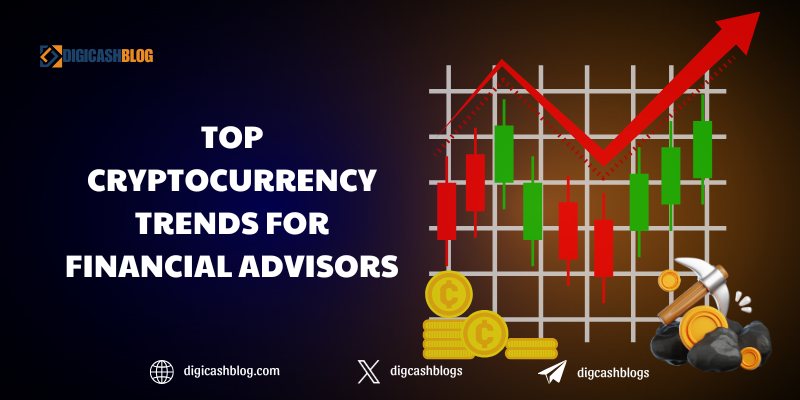The cryptocurrency market, valued at $2.06 trillion in 2025, is increasingly relevant for financial advisors, with 659 million global users and 56% of advisors more likely to invest in crypto due to favorable U.S. policies. Top cryptocurrency trends for financial advisors in 2025 focus on institutional adoption, regulatory clarity, and innovative investment vehicles like ETFs and DeFi. As client inquiries surge—96% of advisors report crypto-related questions—advisors must stay informed to guide portfolios effectively. This article explores key trends, their implications, and strategies for advisors navigating the dynamic digital asset landscape.
Key Trends for Financial Advisors
Surge in Bitcoin and Ethereum ETF Adoption
Spot Bitcoin and Ethereum exchange-traded funds (ETFs), approved in 2024, are a cornerstone for advisors, with $36 billion in assets under management led by BlackRock and Fidelity. The Bitwise/VettaFi 2025 Benchmark Survey reveals 22% crypto allocation among advisors, doubling from 2023, with 99% of those invested planning to maintain or increase exposure. ETFs simplify access, reducing the need for direct crypto custody, and appeal to risk-averse clients. Advisors prioritize low expense ratios (58%) and issuer expertise (46%) when selecting ETFs, making them a preferred vehicle for portfolio diversification.
Growth of Decentralized Finance (DeFi) Opportunities
DeFi, with a projected TVL of $200 billion by 2025, offers advisors new avenues for client portfolios. Platforms like Aave and Uniswap provide yield-generating opportunities through lending and liquidity provision, with stablecoin-based strategies yielding 5-10% APY. Advisors are exploring DeFi baskets via crypto robo-advisors like Shrimpy Advisory, which offer pre-set allocations in DeFi tokens. However, the Senate’s 2025 repeal of DeFi broker reporting rules highlights regulatory leniency, requiring advisors to balance innovation with compliance risks.

Stablecoin Integration in Payments and Remittances
Stablecoins, like USDC and USDT, settle $300 billion daily in 2025, driving their use in remittances and cross-border payments. In regions like South America, stablecoins account for 61.2% of crypto transactions, offering low-cost alternatives to traditional systems. Advisors can recommend stablecoin-based strategies for clients with international exposure, leveraging platforms like Binance Pay for seamless transfers. Regulatory frameworks, such as the U.S. STABLE Act, ensure compliance, making stablecoins a low-volatility option for conservative portfolios.
Tokenization of Real-World Assets (RWAs)
Tokenization of assets like real estate, bonds, and Treasuries is a top trend, with the RWA market reaching $20 billion in Q1 2025. X posts highlight BlackRock’s tokenized U.S. Treasuries, like Ondo Finance’s OUSG, gaining traction on Ethereum layer-2s and Solana. Advisors can use tokenized assets to offer fractional ownership, enhancing liquidity and diversification. This trend aligns with institutional interest, as banks like BNY Mellon integrate tokenized bonds, providing advisors with regulated, blockchain-based investment options.
AI-Driven Crypto Robo-Advisors
AI-powered robo-advisors, such as Shrimpy Advisory and Makara, are simplifying crypto investing for advisors’ clients. These platforms offer tailored baskets, from blue-chip coins like Bitcoin to DeFi and metaverse tokens, based on risk tolerance. The fintech sector, valued at $280 billion in 2025, sees AI enhancing portfolio management and fraud detection. Advisors benefit from automated rebalancing and market monitoring, with Shrimpy’s SEC registration ensuring compliance, making robo-advisors a scalable solution for busy practices.
Drivers of Crypto Trends for Advisors
Client interest is a key driver, with 71% of advisors noting clients invest in crypto independently. The Bitwise/VettaFi survey shows 96% of advisors faced crypto inquiries in 2024, pushing advisors to integrate digital assets. The market’s maturity, marked by ETF approvals and a Strategic Bitcoin Reserve, legitimizes crypto as an asset class, encouraging allocations up to 3-5% for diversification.
The EU’s MiCA framework, U.S. Crypto Task Force, and OECD’s CARF (effective 2026) provide regulatory certainty, reducing barriers for advisors. The repeal of SAB 121 and DeFi reporting rules in 2025 eases compliance burdens, while Trump’s crypto-friendly appointees signal a supportive environment. These policies attract institutional capital, with $485 million in Q1 2025 blockchain investments, bolstering advisor confidence.
Layer-2 solutions, like Arbitrum, and AI integration enhance transaction efficiency and portfolio management. Zero-knowledge proofs (ZKPs) support private DeFi transactions, aligning with client privacy demands. These advancements make crypto more accessible, enabling advisors to recommend sophisticated strategies without technical expertise.

Challenges for Advisors
- Volatility and Risk Management
Crypto’s volatility, with Bitcoin’s Q1 2025 dip due to tariffs, poses risks. Advisors must use tax-loss harvesting and rebalancing, as practiced by Shorehaven Wealth Partners, to manage exposure. Stablecoins and ETFs mitigate volatility but require careful monitoring.
- Regulatory Compliance Costs
Form 1099-DA reporting, starting 2025, increases compliance costs for exchanges and advisors. In India, a 30% VDA tax complicates global strategies. Advisors must leverage tax software like Koinly to ensure accurate reporting, especially for DeFi and staking income.
- Limited Access and Education
Only 35% of advisors can buy crypto for clients, per Bitwise/VettaFi, due to platform restrictions. Limited crypto education among advisors, coupled with complex tax rules, hinders adoption. Partnerships with platforms like Eaglebrook, offering tax optimization, can bridge this gap.
Strategies for Financial Advisors
- Partnering with Crypto Robo-Advisors
Advisors should collaborate with platforms like Shrimpy Advisory to offer diversified crypto baskets, reducing management overhead. These tools align with client risk profiles and simplify compliance.
- Educating Clients on Risks and Opportunities
Advisors must educate clients on crypto’s volatility and tax implications, using resources like DACFP’s certification programs. Highlighting stablecoins and tokenized assets as low-risk options can build trust.
- Leveraging Regulatory Clarity
Staying updated on MiCA, CARF, and U.S. policies ensures compliant strategies. Advisors should consult crypto tax professionals to navigate Form 1099-DA and international tax regimes, optimizing client outcomes.
Future Outlook
Top cryptocurrency trends for financial advisors in 2025 point to a mainstream crypto era, with ETF allocations, DeFi growth, and RWA tokenization driving adoption. By 2027, DeFi’s TVL may hit $300 billion, and stablecoin settlements could reach 10% of global payment volumes. Advisors integrating crypto, supported by AI and regulatory clarity, will meet rising client demand, positioning portfolios for long-term growth in a digital economy.
